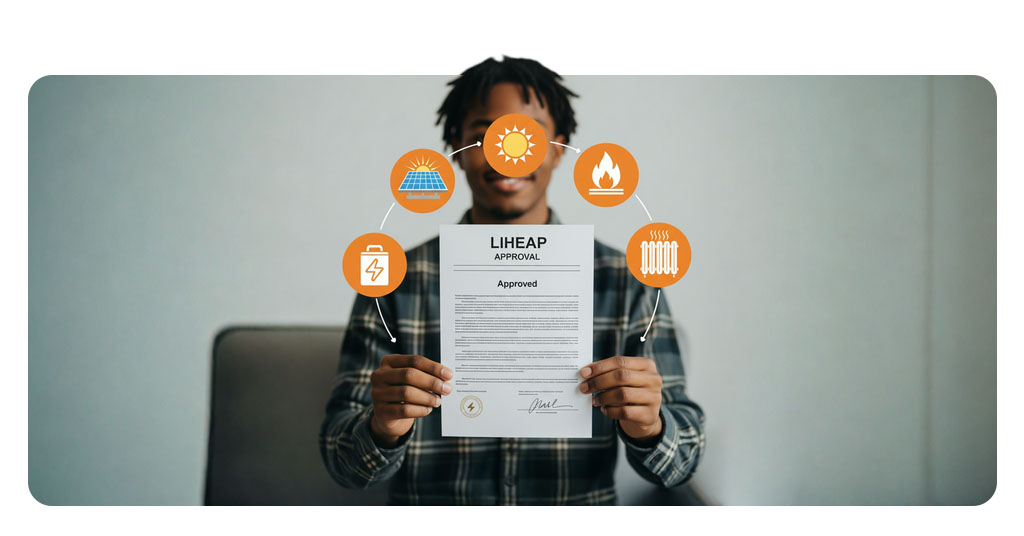Getting behind on utility bills can happen to anyone, especially during times of financial hardship. The good news is that there are government-funded programs and nonprofit resources designed to help. These programs can reduce your monthly costs or cover overdue payments.
In this guide, you’ll learn how to apply for utility bill relief through LIHEAP and similar services. We’ll also show you how to find state-specific programs tailored to your needs. Plus, get practical energy-saving tips to cut costs in the long run. If you’re feeling overwhelmed, know that real help is just a few steps away.
- Efficienza energetica della casa: Applicazioni per ridurre i costi delle bollette
- Non perdete mai una data di scadenza con questa app di promemoria per le bollette
- La migliore app di cashback per le bollette
How to Get Help Paying Your Utility Bills
Rising energy costs make utility bills unaffordable for many households, but government and nonprofit programs can provide financial relief.
The Low Income Home Energy Assistance Program (LIHEAP), administered by the U.S. Department of Health and Human Services, offers grants to help cover:
- Electricity;
- Heating (gas, oil, propane);
- Water bills;
- Emergency furnace repairs.
Who Qualifies?
- Households earning ≤ 150% of the Federal Poverty Level;
- Those receiving SNAP, SSI, or TANF benefits;
- Seniors, disabled individuals, and families with young children.
Apply now: Check eligibility at LIHEAP’s official site.
Which States Offer Energy Assistance Programs?
The Low Income Home Energy Assistance Program (LIHEAP) provides critical utility bill support in all 50 states, but benefit amounts, eligibility rules, and application processes vary significantly by location.
Below is a detailed breakdown of state-specific programs to help you maximize available assistance.
State-by-State LIHEAP Benefits (2024-2025 Season)
| State | Maximum Benefit | Special Provisions | Apply Online |
| California | Up to $1,000 | Additional crisis funds for shut-off notices | Apply Here |
| New York | Up to $900 (HEAP) | Emergency repairs for broken furnaces | NY HEAP Portal |
| Texas | Up to $1,200 | Covers cooling costs in summer | Texas DHS |
| Florida | Up to $600 | Prioritizes households with elderly/disabled | Florida LIHEAP |
| Illinois | Up to $1,500 | Separate weatherization grants available | Illinois Application |
Key Variations to Note:
- Northern states (e.g., Minnesota, Michigan) typically offer higher heating benefits;
- Southern states (e.g., Arizona, Georgia) may prioritize summer cooling assistance;
- Tribal LIHEAP programs provide enhanced benefits for Native households.
How to Find Your State’s Exact Benefits
- Use the LIHEAP State Locator Tool on the official federal site
- Call your local Community Action Agency (find via 211.org)
- Check supplemental programs like:
- Weatherization Assistance Program (WAP) – Free home insulation;
- Utility company hardship funds (e.g., PG&E’s CARE program).
When to Apply
- Best time: applications typically open October 1 for winter assistance;
- Deadlines: most states exhaust funds by March;
- Priority groups: elderly (60+), disabled, and families with young children get first consideration.
Pro tip: some states (like Colorado) allow pre-registration before the official application period begins.
For a complete, updated list of all state programs, visit:
Remember: even if you’ve been denied before, reapply annually—income limits and benefit amounts change frequently. Many eligible households miss out simply because they don’t submit updated applications.
Next Steps:
- Bookmark your state’s LIHEAP website;
- Gather current income documentation;
- Set a calendar reminder for next year’s application period.
For those needing immediate help, local Salvation Army chapters often provide emergency utility assistance while LIHEAP applications process.

What You Need to Apply for LIHEAP
Applying for LIHEAP is easier when you’re prepared. This federal program offers energy bill assistance to low-income households, but you’ll need to gather key documents first.
Proof of income, identification, and recent utility bills are commonly required. Knowing what to bring can speed up the process and help you get approved faster.
Required Documents
- Proof of income (pay stubs, tax returns, or benefit letters);
- Utility bills (past due or current);
- ID and Social Security cards for all household members;
- Proof of residence (lease or mortgage statement).
How to Submit Your Application
- Online: most states allow applications via their LIHEAP portals;
- In person: visit local Community Action Agencies;
- By mail: download forms from your state’s LIHEAP website.
Processing time: typically 30 days, but emergency cases (e.g., shut-off notices) are fast-tracked.
Tips to Save Energy and Cut Costs at Home
Cutting down on your energy use doesn’t just help the planet—it helps your wallet too. Simple changes at home, like sealing drafts or using energy-efficient lightbulbs, can make a big difference.
These small habits reduce your monthly bills and boost overall comfort. Let’s explore practical tips you can start using today.
Weatherize Your Home
- Apply for the Weatherization Assistance Program (WAP), which provides free insulation, window sealing, and energy audits (Apply here).
Adjust Thermostat Settings
- Set to 68°F in winter and 78°F in summer to reduce HVAC costs.
Switch to Energy-Efficient Appliances
- Look for rebates via the ENERGY STAR program.
Negotiate Payment Plans
- Many utility companies offer deferred payment options if you call before disconnection.
How to Reapply Each Year and Stay Eligible
LIHEAP benefits do not renew automatically. To continue receiving aid:
- Reapply every fall (applications open October–April);
- Update income documentation if your financial situation changes;
- Check for additional aid through:
- Salvation Army utility assistance (apply here);
- 211’s local bill-pay programs (search here).
Take Action Now
If you’re struggling with utility bills:
- Apply for LIHEAP before funds run out;
- Contact your utility provider for payment plans;
- Use energy-saving hacks to lower future costs.
For more financial planning resources, see our guide on retirement savings strategies.Need immediate help? Call 211 or visit USA.gov’s utility assistance page.





